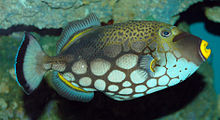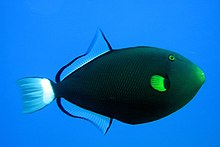Triggerfish
| Triggerfish | ||||||||||||
|---|---|---|---|---|---|---|---|---|---|---|---|---|

Picasso triggerfish |
||||||||||||
| Systematics | ||||||||||||
|
||||||||||||
| Scientific name | ||||||||||||
| Balistidae | ||||||||||||
| Risso , 1810 |
The triggerfish (Balistidae) are a family of the order of the pufferfish relatives (Tetraodontiformes). They inhabit tropical and subtropical areas of the Atlantic, Indian and Pacific Oceans, especially coral reefs . Only a few species live pelagic in the open ocean. The Gray triggerfish ( Balistes capriscus ) is also in the Mediterranean before and is the only triggerfish Irrgast in the North Sea .
features
Triggerfish grow to be 16 centimeters to one meter long and have a strong, tall body with flattened sides. Often they are brightly colored and strikingly patterned. Your body is covered with thick skin and small, non-overlapping scales. The scales often have small spines. Triggerfish only ever have 18 vertebrae. The spatula, sickle or lyre-shaped caudal fin has twelve fin rays . The head with the high-set and set-back eyes, which they can move independently of one another, takes up a very large part - up to a third - of the body's length. Due to the size of the jockstrap , the hyomandibles and quadratum are unusually far apart, but they are still firmly connected by the very large preoperculum . The purpose of this striking construction is to protect the eyes when gathering food. The mouth itself is very small, but equipped with strong, chisel-like teeth. In the upper jaw there are usually four teeth in the first row and three teeth in the second row on each premaxillary , for a total of 14 teeth. Triggerfish swim mainly through undulating ("flapping") movements of their symmetrically opposite, soft-rayed second dorsal fin and anal fin . Their often inclined swimming position is striking. The tail fin acts as a rudder and is only used for propulsion at higher speeds (balistiform swimming).
The pusher mechanism
The first dorsal fin is hard-edged and has three rays , the third can be very small or absent. The first and longest fin beam together with the second fin beam forms the trigger mechanism to which the fish owe their German name. The first fin spike can be set up and fixed by the second by snapping it into a V-shaped groove on the back of the first. So the first ray of fin can only be put down again when the second is pulled backwards by pulling the muscles. If the third fin ray is also present, it must be turned over before the second. Together with the overgrown pelvic fins - which only represent a sawn, strong fin spine consisting of fused rays, which is connected to the pelvis by a joint and flexible skin - the fish can clamp themselves in crevices in the coral and rock reefs and are like that difficult to capture from predators. The animals also sleep in this position. They usually use the same sleeping place and only change it as they grow taller. When swimming, the hard rays are laid back in a furrow on the back and are then not visible. The closely related filefish have the same trigger mechanism .
Before the pusher mechanism was known, the Balistidae were called hornfish because of the large, thick dorsal spine - especially since the "horn" is close to the head ("horn" and "brain" are of the same origin - both belong to the head).
Lute
Triggerfish are among those fish that are able to make clearly audible sounds. They can grind their teeth, rub areas of the shoulder girdle on the swim bladder and thus generate drumming noises. If you fold your first dorsal fin ray up and down and let the second snap in and out, you will hear a loud crack.
Lifestyle and diet
Triggerfish live mainly near the bottom and in solitary form, Rhinecanthus species form schools when they are young, the red-toothed triggerfish and the Indian triggerfish form loose groups during the day. The solitary species are territory-forming . Their density of individuals in suitable habitats is often very high.
Triggerfish feed mainly on hard-shelled invertebrates such as crustaceans , molluscs , echinoderms , as well as corals, sponges, sea squirts , small fish, zooplankton , algae and seaweed are consumed by some species. When searching for prey, they can use their mouths to lift stones or corals or create a jet of water that exposes their food on the sea floor (hence the narrow gill openings). Sea urchins are turned over with a jet of water by some triggerfish species so that they are with their vulnerable side up.
Reproduction and territorial behavior
Triggerfish show little sex difference, mostly the males are larger and more intensely colored. Often times, the females have small territories within a larger area owned by a male. Most bottom-dwelling species lay their eggs in large funnel-shaped pits, which they dig into the sandy soil by blowing a jet of water on them. It spawns at dusk, often one day before the new moon . The clutch consists of tiny eggs attached to the ground in a disk-shaped mass and is fanned, guarded and very aggressively defended by the female. They warn an opponent of an attack with a headstand. Then they swim towards the opponent at great speed and turn away at the last moment. If the enemy is still getting closer, ram or bite him in the next attack. Giant triggerfish guarding clutches attack divers as soon as they approach within ten meters. They drum when defending the territory.
The larvae hatch after 12 to 24 hours, then live pelagic in the open ocean for a very long time and thus spread very widely. In some species, the juvenile fish are already 15 centimeters long when they move on to the life of the adults near the ground.
The pelagic species spawn in the open ocean and do not practice brood care. Their eggs are also pelagic.
External system
Triggerfish belong to the pufferfish relatives (Tetraodontiformes) and together with their sister group , the filefish (Balistidae), form the suborder Balistoidei. In older publications the filefish are often still counted as the subfamily Monacanthinae to the triggerfish.
species
There are 12 genera and 43 species:
-
Abalistes Jordan & Seale, 1906
- Abalistes filamentosus Matsuura & Yoshino, 2004
- Star triggerfish ( Abalistes stellaris ) ( Bloch & Schneider , 1801)
- Abalistes stellatus (Anonymous, 1798)
-
Balistapus Tilesius, 1820
-
Orange-striped triggerfish ( Balistapus undulatus ) (Park, 1797)
 Orange Triggerfish ( Balistapus undulatus )
Orange Triggerfish ( Balistapus undulatus )
-
Orange-striped triggerfish ( Balistapus undulatus ) (Park, 1797)
-
Balistes Linnaeus , 1758
- Gray triggerfish ( Balistes capriscus ) Gmelin, 1789
- Balistes ellioti Day, 1889 (doubtful)
- East Pacific triggerfish ( Balistes polylepis ) Steindachner, 1876
- Balistes punctatus Gmelin, 1789
- Balistes rotundatus Marion de Procé, 1822
- Queen triggerfish ( Balistes vetula ) Linnaeus, 1758
- Balistes willughbeii Lay & Bennett, 1839
-
Balistoides Fraser-Brunner, 1935
-
Leopard triggerfish ( Balistoides conspicillum ) (Bloch & Schneider 1801)
 Leopard triggerfish ( Balistoides conspicillum )
Leopard triggerfish ( Balistoides conspicillum ) - Giant triggerfish ( Balistoides viridescens ) (Bloch & Schneider 1801)
-
Leopard triggerfish ( Balistoides conspicillum ) (Bloch & Schneider 1801)
-
Canthidermis Swainson , 1839
- Canthidermis macrolepis (Boulenger, 1888)
- Snowflake triggerfish ( Canthidermis maculata ) (Bloch, 1786)
- Canthidermis sufflamen (Mitchill, 1815)
-
Melichthys Swainson, 1839
- Indian triggerfish ( Melichthys indicus ) Randall & Klausewitz, 1973
- Black triggerfish ( Melichthys niger ) (Bloch, 1786)
-
Widow triggerfish ( Melichthys vidua ) (Richardson, 1845)
 Widow triggerfish ( Melichthys vidua )
Widow triggerfish ( Melichthys vidua )
-
Odonus Gistel, 1848
- Red-tooth triggerfish ( Odonus niger ) (Rüppell, 1836)
-
Pseudobalistes Bleeker, 1865
- Yellow-fringed triggerfish ( Pseudobalistes flavimarginatus ) (Rüppell, 1829)
- Blue-stripe triggerfish ( Pseudobalistes fuscus ) (Bloch & Schneider, 1801)
- Pseudobalistes naufragium (Jordan & Starks, 1895)
-
Rhinecanthus Swainson, 1839
- Rhinecanthus abyssus Matsuura & Shiobara, 1989
- Picasso triggerfish ( Rhinecanthus aculeatus ) (Linnaeus, 1758)
-
Red Sea Picasso triggerfish ( Rhinecanthus assasi ) (Forsskål, 1775)
 Rhinecanthus assasi ( Rhinecanthus assasi )
Rhinecanthus assasi ( Rhinecanthus assasi ) - Rhinecanthus cinereus (Bonnaterre, 1788)
- Rhinecanthus lunula Randall & Steene, 1983
- Diamond Picasso triggerfish ( Rhinecanthus rectangulus ) (Bloch & Schneider, 1801)
- Belly-spot Picasso triggerfish ( Rhinecanthus verrucosus ) (Linnaeus, 1758)
-
Sufflamen Jordan , 1916
- Sufflamen albicaudatum (Rüppell, 1829)
- Boomerang triggerfish ( Sufflamen bursa ) (Bloch & Schneider, 1801)
- White-rim triggerfish ( Sufflamen chrysopterum ) (Bloch & Schneider, 1801)
- Sufflamen fraenatum (Latreille, 1804)
- Sufflamen verres (Gilbert & Starks, 1904)
-
Xanthichthys Kaup in Richardson, 1856
- Bluethroat triggerfish ( Xanthichthys auromarginatus ) (Bennett, 1832)
- Xanthichthys caeruleolineatus Randall, Matsuura & Zama, 1978
- Xanthichthys greenei Pyle & Earle, 2013
- Xanthichthys lima (Bennett, 1832)
- Xanthichthys lineopunctatus (Hollard, 1854)
- Xanthichthys mento (Jordan & Gilbert, 1882)
-
Sargasso triggerfish ( Xanthichthys ringens ) (Linnaeus, 1758)
 Sargasso triggerfish ( Xanthichthys ringens )
Sargasso triggerfish ( Xanthichthys ringens )
-
Xenobalistes Matsuura, 1981
- Xenobalistes tumidipectoris Matsuura, 1981
Fossil record
With Oligobalistes robustus from the lower Oligocene of the North Caucasus, a fossil triggerfish is also known.
use
In contrast to many other pufferfish relatives, triggerfish are not poisonous, nor are their innards, and are consumed by humans. The algae-eating species can, however, cause ciguatera poisoning in humans. Particularly brightly colored triggerfish species are also caught alive for aquarium purposes and exported to wealthy countries. However, they are usually too big for private aquariums and are snappy towards fish that are associated with them. They are also often shown in large public show aquariums.
literature
- Joseph S. Nelson : Fishes of the World . John Wiley & Sons, 2006, ISBN 0-471-25031-7
- Kurt Fiedler: Textbook of Special Zoology, Volume II, Part 2: Fish . Gustav Fischer Verlag Jena, 1991, ISBN 3-334-00339-6
- Hans A. Baensch / Robert A. Patzner: Mergus Sea Water Atlas Volume 6 Non-Perciformes (Non-Perciformes) , Mergus-Verlag, Melle, 1998, ISBN 3-88244-116-X
- Ewald Lieske, Robert F. Myers: Coral fish of the world . 1994, year publisher, ISBN 3-86132-112-2
Individual evidence
- ^ Karl Albert Frickhinger: Fossil Atlas Fish , Mergus-Verlag, Melle, 1999, ISBN 3-88244-018-X
Web links
- Triggerfish on Fishbase.org (English)

